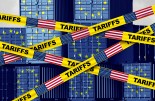State Street SPDR ETF: Positioning for easing cycle with European Barbell

The euro area growth remains weak and the Consumer Price Index (CPI) has fallen to 2.6% YoY, which has prompted the European Central Bank (ECB) to hint at potential rate cuts around mid-year. Around 25 bps of cuts are priced in for the June meeting and close to 90 bps for the remainder of 2024.
With a cut potentially coming as soon as late Q2, it makes sense to choose a barbell approach. Barbelling risk in European markets remains attractive because it can provide a higher yield than just a straight government exposure for the same duration risk. There is also additional convexity, which can aid performance when growth decelerates quickly.
Government bonds, high-quality credit — or perhaps both
In the 2008–2009 easing cycle, government bonds clearly outperformed IG credit. Credit spreads blew out aggressively and positive returns did not materialise until the easing cycle had finished. In late 2011-2012 credit performed better, but even then, returns from European government bonds were marginally stronger. This may have resulted from the longer duration of the government strategy and the tendency for credit spreads to widen if a material slowdown is anticipated.
The downside of sticking to government exposures is giving up some yield. This can particularly hamper returns if the central bank is late to start the easing cycle. However, the short-dated IG exposure embedded in the barbell provides yield uplift of over 70 bps to government bonds. Couple this with a long-dated (10+ years) government exposure and you exclude the middle part of the curve, which is the low point for yields (around the 7-year maturity). When structured versus the Bloomberg Euro Aggregate Treasury Index, it provides an annual yield pick-up of 67 bps. This will support returns if the ECB holds off on rate cuts if, for instance, inflation does not fall back as projected.
Last, the long-end exposure adds in some convexity, with the barbell having over 25% more convexity than the all curve exposure. This may prove trivial for performance on market moves of a modest magnitude, but it buys protection in the event of a sharp slowing in the economy. The European economy is cruising close to stall speed, meaning any deterioration in growth momentum could force the ECB to act more forcefully. In this case, the additional convexity should support barbell returns.
Jason Simpson, Senior Fixed Income Strategist at State Street SPDR ETFs:
'Many of the same arguments above are applicable to the UK market. Growth has proved persistently weak, with the UK experiencing a technical recession in the second half of 2023. A more meaningful deterioration would significantly increase pressure on the Bank of England (BoE) to cut policy aggressively. Inflation has declined dramatically, with CPI undershooting expectations in February at 3.4% YoY. Even the BoE Monetary Policy Committee (MPC) is split on the timing of a cut, with one member already voting to cut rates. The market is less convinced of an imminent move and the first cut is not priced in until the August meeting.
There is an additional reason to consider barbelling risk: there has been a material re-pricing of the long end of the UK curve. The 15-year forward gilt rate is close to 5%, near the top of its historical range. The absolute highs were at 5.36% in 2009, but it typically has not traded above 5% for any period of time. The term premium rebuild appears more advanced in UK markets, with the chart below showing how the 10–30-year spread is now far steeper than it was in 2007 and 2008, the last time that the 2-year gilt yield was at similar levels.'








